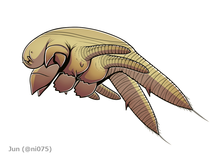Sea spider
Arachnopoda Dana, 1853 Sea spiders are marine arthropods of the class Pycnogonida,[1] hence they are also called pycnogonids (/pɪkˈnɒɡənədz/;[2] named after Pycnogonum, the type genus;[3] with the suffix -id).While some literature around the 2000s suggests they may be a sister group to all other living arthropods,[8][9] their traditional classification as a member of chelicerates alongside horseshoe crabs and arachnids has regained wide support in subsequent studies.It consists of an anterior proboscis, a dorsal ocular tubercle with eyes, and up to four pairs of appendages (chelifores, palps, ovigers and first walking legs).Although some literature might consider the segment carrying the first walking leg (somite 4) to be part of the trunk,[6] it is completely fused to the remaining head section to form a single cephalic tagma.However In those species that have reduced chelifores and palps, the proboscis is well developed and flexible, often equipped with numerous sensory bristles and strong rasping ridges around the mouth.[23] The chelifores are used for feeding and the palps are used for sensing and manipulating food items,[24] while the ovigers are used for cleaning themselves, with the additional function of carrying offspring in males.[28][15] Several alternatives had been proposed for the position homology of pycnogonid appendages, such as chelifores being protocerebral/homologous to the labrum (see text)[9] or ovigers being duplicated palps.[17] A pair of gonads (ovaries in female, testes in male) is located dorsally in relation to the digestive tract, but the majority of these organs are branched diverticula throughout the legs because the body is too small to accommodate all of them alone.[40] This third brain segment, or tritocerebrum (corresponding to the palps/somite 2), is fused to the oviger/somite 3 ganglia instead, which is followed up by the final ovigeral somata in the protonymphon larva of Pycnogonum litorale.[12][6] Sea spiders are mostly carnivorous predators or scavengers that feed on soft-bodied invertebrates such as cnidarians, sponges, polychaetes, and bryozoans, by inserting their proboscis into targeted prey item.At least some species have obvious defensive methods such as amputating and regenerating body parts,[45][46] or making itself unpleasant meal via high level of ecdysteroids (ecdysis hormone).[47] On the other hand, sea spiders are known to be infected by parasitic gastropod mollusks[48][49] or hitch‐rided by sessile animals such as goose barnacles, which may negatively affect their locomotion and respiratory efficiency.[50] All sea spiders have separate sexes, except the only known hermaphroditic species Ascorhynchus corderoi and some extremely rare gynandromorph cases.In this stage, the chelifores usually have attachment glands, while the palps and ovigers are subequal, three-segmented appendages known as palpal and ovigeral larval limbs.This Cormogonida hypothesis was first indicated by early phylogenomic analysis aroud that time,[8] followed by another study suggest that the sea spider's chelifores are not positionally homologous to the chelicerae of euchelicerates (originated from the deutocerebral segment/somite 1), as was previously supposed.Instead, the chelifore nerves were thought to be innervated by the protocerebrum, the first segment of the arthropod brain which corresponded to the ocular somite, bearing the eyes and labrum.If that's true, it would have meant the sea spiders are the last surviving (and highly modified) members of an ancient, basal arthropods that originated in Cambrian oceans.Under the basis of phylogenomics, this is one of the only stable topology of chelicerate interrelationships in contrast to the uncertain relationship of many euchelicerate taxa (e.g. poorly resolved position of arachnid orders other than tetrapulmonates and scorpions; non-monophyly of Arachnida in respect to Xiphosura).[63] stem-groups (e.g. Palaeoisopus, Flagellopantopus, Palaeopantopus) Austrodecidae Colossendeidae Rhynchothoracidae Pycnogonidae Endeidae Phoxichilidiidae Pallenopsidae Ammotheidae Ascorhynchidae(including Nymphonella?)[16] Phylogenomic analysis of extant sea spiders was able to establish a backbone tree for Pantopoda, revealing some consistent relationship such as the basal position of Austrodecidae, monophyly of some major branches (later redefined as superfamilies[26]) and the paraphyly of Callipallenidae in respect to Nymphonidae.[65][33][66][26][6] While some phylogenetic analysis placing them within Pantopoda, this result is questionable as they have low support values and based on outdated interpretation of the fossil taxa.So far only its protonymphon larvae had been described, featuring some traits unknown from other pycnogonids such as paired anterior projections, gnathobasic larval limbs and annulated terminal appendages.












PreꞒScientific classificationEukaryotaAnimaliaArthropodaChelicerataLatreilleGerstaeckerType genusPycnogonumBrünnichSynonymsarthropodsPaleozoiccosmopolitanAntarcticdeep watersspidersarachnidssister groupchelicerateshorseshoe crabsCallipallene brevirostrissomitesexoskeletontergitesterniteChaetonymphon spinosumproboscisappendagescheliforesAustrodecidaehomologylabrumocellicompound eyesPseudopallenePycnogonum litoraleColossendeisNymphonNymphonidaepincerPycnogonidaeNullovigerColossendeidaePhoxichilidiidaeAmmotheidaeCallipallenidaeDecolopodamuscular systemserial homologyPalaeoisopusHaliestesPalaeopantopusFlagellopantopusPentapycnonPentacolossendeisDodecolopodaPentanymphonSexanymphonneuroanatomicgeneticcheliceraepedipalpstelsonreproductive systemspharynxgonadsovariestestesdigestive tractEndeisgonoporecementrespiratory systemdiffusionsurface-area-to-volume ratioOxygenhemolymphblood pressureperistaltic movementcentral nervous systemsupraesophageal ganglionventral nerve cordsesophagusgangliahydroidAustraliaNew ZealandPacificUnited StatesMediterranean SeaCaribbean Seabenthicnektoniccarnivorouspredatorsscavengerscnidariansspongespolychaetesbryozoanssea anemonesparasitebivalvemollusksamputatingregeneratingecdysteroidshormonegastropodsessilegoose barnacleshermaphroditicgynandromorphexternal fertilisationmetamorphosisanamorphiccrustaceannaupliusmegacheiranlecithotrophichydrozoansXiphosuraArachnidaMandibulata
